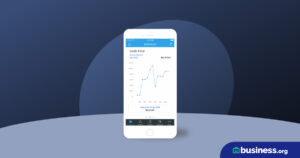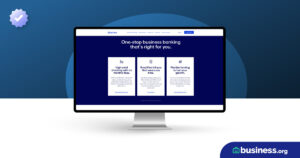💸 See if your business qualifies for a tax credit worth up to $26k per employee. 📞 Call Now: 855-979-9597
How to Write an Invoice for Small Business Owners
We are committed to sharing unbiased reviews. Some of the links on our site are from our partners who compensate us. Read our editorial guidelines and advertising disclosure.
As a small business owner, invoicing your clients on time is essential.
Creating an invoice may feel foreign if you’ve never done it before. But really, an invoice is just a way to record the hard work you've completed and ask for payment.
We’ll guide you through how to write an invoice and explore different ways to invoice clients, including using templates and software.
Follow these steps and you'll be ready to start creating professional invoices in no time.
What is an invoice and when do you send one?
An invoice is a document that lists the services or goods you've provided to a client along with the amount you're owed.
An invoice should clearly state what a customer purchased, the date they purchased it and how much they owe.
You should typically send out a sales invoice as soon as goods are delivered or after a service is provided. But you may also choose to invoice your customers on a schedule, such as once a week or once a month.
What to include in an invoice
Each professional invoice includes certain information. Here's a breakdown of the essential elements of an invoice:
- Your business address, phone number and email address
- Your client's name, address, phone number and email address
- Invoice number
- Invoice issue date and due date
- Description of the goods or services provided
- Quantity of goods or services provided
- The rate or price per item or hour
- A subtotal
- Any discounts
- Any sales tax
- Total amount due
- Payment terms
- Payment methods accepted
- Late payment fees, if applicable
Should you use invoice software or invoice templates?
Next, you’ll need to decide how you’ll create your invoice. You can use invoicing software or an invoice template.
Invoicing software lets you quickly and easily create invoices and share them with clients.
In most cases, the software will automatically populate an invoice with your business details, including your company’s name and mailing address.
Some popular invoicing software includes Zoho, QuickBooks, Xero and FreshBooks.
It makes sense to use invoicing software if you have a high sales volume or need advanced features, such as payment tracking and automation.
Alternatively, you can use a free invoice template to create your statement.
There are lots of invoice templates to choose from online, such as Wave Accounting, which is free for life and includes many other features. You can also find invoice templates in Microsoft Word and Google Docs that you can customize and save.
Using a free invoice template may be a better fit if you have a simple billing process or only need to create a few invoices.
Top billing & invoicing software for small businesses
Data as of 5/3/23. Offers and availability may vary by location and are subject to change.
*30-day free trial or 50% off for 3 mos.
**30-day free trial or 50% off for 3 mos.
How to write an invoice in 6 steps
Whether you use online invoicing software to generate statements or opt for an invoice template instead, the basic steps remain the same.
Step 1: Customize your invoice and add your details
The header of your invoice should include your contact details, including your business name, address, phone number and email address.
You should also include your logo if you have one and incorporate your company’s colors. This will help make your invoice look more professional.
Step 2: Include the client’s information
Below the invoice header, include the client’s name, address, phone number and email address.
Make sure this information is accurate and up-to-date. Sending out an invoice with incorrect or missing information can cause confusion and delay payment.
If you are billing a company, include the name of the company and the name of the person who authorized the work.
Step 3: Add an invoice number and date
Each statement should include three different numbers: the invoice number, the issue date and the due date.
The invoice number is a unique code assigned to each document. The number makes it easier to track your invoices and ensures that each one is paid correctly.
You should also include the invoice date (the date you created the invoice) and when the payment is due.
Step 4: List the details of the work performed
This is the most important section of your invoice. List the details of the work you performed, including:
- Date of the job
- Hours worked or number of units
- The agreed upon rate
Be specific and include as much detail as possible when you write an invoice. If you are billing for multiple items, create a separate line item for each one.
If you’re required to collect taxes on your work, include them on the invoice. You should also detail any discounts or fees that apply to the work you performed. Make sure the total amount due is accurate.
Finally, you might want to include a footnote clarifying any information at the bottom. For example, describing conditions under which customers can return or exchange items can help avoid disputes and late payments.
Step 5: Provide payment details and instructions
When you write an invoice, make it clear to your client how they can pay you. Include your preferred payment method — such as a check or PayPal.
You should also include payment terms, which describe when you expect to get paid.
Net 30 is a common payment term on invoices. This means the client has 30 days from the invoice date to pay you.
Due on receipt is another common option, and it means the client must pay you as soon as they receive the invoice.
You might even consider offering clients a discount for early payment. A little incentive could help you get paid faster.
The best banks for small businesses
Data effective 4/20/23. At publishing time, rates, fees, and requirements are current but are subject to change. Offers may not be available in all areas.
Step 6: Send your invoice
Try to send out the invoice as soon as the work is complete or the goods have been delivered. After all, the sooner you send it, the sooner you can collect payment.
If you’re using invoicing software, you can usually email the document to the client directly from the software. If you’re using an invoice template, you can either email the invoice as a PDF attachment or print it out and mail the invoice to the customer.
If you send your invoice via email, make sure to include the word “invoice” in the subject line.
If the client doesn’t pay you within the specified time, don't be afraid to follow up with a friendly email or phone call.
Pro tip: Still waiting on a payment? Here are some tips for getting invoices paid on time.
Stay organized and keep track of invoices
Once you’re comfortable with the invoicing process, it’s important to keep your documents organized and accessible.
Using accounting software is one of the easiest ways to keep your invoices organized in one place. Many software programs also help you track payments and create financial reports.
If you’re using an invoicing template, create a spreadsheet to track your invoices.
You can create columns for the invoice number, client name, due date and payment status so you can easily track which invoices are outstanding and which have been paid.
Using a document management system, such as Dropbox, can also help you streamline the invoicing process by storing, managing and retrieving statements.
Compare the year's best accounting software
Data as of 5/3/23. Offers and availability may vary by location and are subject to change.
*Only available for businesses with an annual revenue beneath $50K USD
**Current offer: 50% off for 3 mos. or 30-day free trial
†Current offer: 50% off for three months or 30-day free trial
‡Current offer: 75% off for 3 mos. Available for new customers only
Frequently Asked Questions (FAQs)
Business-to-consumer sales require either a receipt or an invoice. Small businesses need to invoice to keep track of their sales and ensure timely payment from customers. Invoicing also helps communicate payment terms to clients, which can help avoid disputes. Finally, invoices are important for recordkeeping and tax purposes.
You can include your company’s employer identification number (EIN) on an invoice, but it isn’t required.
An invoice and a bill are basically the same thing, but the two words are used by different people to describe the same transaction. A business owner usually calls this document an invoice while a customer usually calls it a bill. They are both statements about the goods or services provided and the amount due.
A note: Invoices may include more details than a bill. For example, payment terms like net-30 are usually displayed on an invoice but may not be included on a bill.
Rachel Christian is a Certified Educator in Personal Finance and a senior writer at The Penny Hoarder. She focuses on small businesses, retirement, investing and taxes.








